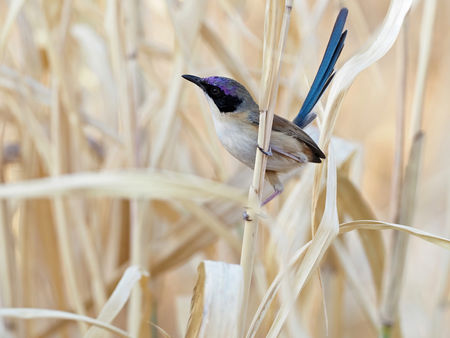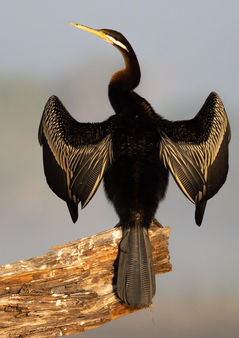
Australia's Top End: Victoria River to Kakadu - Birding Tour
Tour Overview:
This tour focuses on the Top End, the most diverse part of the Northern Territory. It is home to some truly spectacular birds, including the gorgeous Gouldian Finch, the delightful Purple-crowned Fairywren, the glistening Rainbow Pitta, and the ultramarine Hooded Parrot, all of which are usually seen, and are not possible on other Australia tours offered. Along with these “prize-winning” birds is a fascinating landscape comprising of wet monsoon forests, dry Eucalypt savanna and stunning sandstone canyons, in addition to some truly fascinating Aboriginal culture, including the ancient aboriginal rock galleries of Nourlangie Rock in Kakadu. This tour offers up a real taste of the outback along with a number of highly localized species only found in the Top End. It, therefore makes for a great combination with our very popular eastern Australia tour, as both tours have a completely different feel and visit very different areas of this absorbing continent.
Upcoming Departures:
Ready to Book?
2022
19 -27 October (US$6300; single supplement: US$680)
2023
20 - 28 October (US$6900; single supplement: US$680)
Other Tour Details:
Length: 9 Days
Starting City: Darwin
Ending City: Darwin
Pace: Moderate
Physical Difficulty: Moderate
Focus: Birding, Wildlife, Culture
Max group size: 7 + 1 leader
Detailed Itinerary
Day 1: Arrival in Darwin. The tour starts at noon
Our first day in the Top End will see us visiting a number of easily accessible birding sites close to Darwin, packing in as many birds as possible before dark. We’ll begin in mangroves near Nightcliff where we will be searching for specialties of this habitat, like Mangrove Fantail, Mangrove Gerygone, Australian Yellow White-eye, Red-headed Myzomela, Black-tailed Whistler, and the rare and local White-breasted Whistler. After it starts to heat up we will head over to Buffalo Creek where we have a shot at the ridiculously loud Chestnut Rail, either feeding on the exposed mud or skulking in the mangroves. The beach that borders these mangrove stands often holds Great-billed Heron among a smattering of regular Aussie shorebirds, like Greater and Lesser Sandplovers, Great Knot, Terek Sandpiper, and Red-necked Stint. Late in the afternoon, we will check in on a local pair of Rufous Owls. We spend the first night in Darwin.
Day 2: East Point and Fogg Dam to Katherine
Dawn will see us at East Point having breakfast in the field with Rainbow Pittas and Rose-crowned Fruit-Doves for company. Later we drive to one of the Top End’s premier wetlands, Fogg Dam. Around the dam itself, we’ll be thrilled with the site of thousands of wetland birds, including Magpie-Geese, Pied Herons, Green Pygmy-Geese, and maybe a Buff-banded Rail or White-browed Crake scurrying out of the reeds. In the monsoon forest, we have further chances at the Top End’s sexiest bird (if needed): the Technicolor Rainbow Pitta. Later, we head southwards to Pine Creek, stopping off at this old gold mining area for the opalescent Hooded Parrot. We overnight in Katherine.
Day 3: Katherine to Timber Creek
Today we’ll drive to Timber Creek for a two-night stay, but not before spending time at dawn around a local waterhole for our first shot at the stunning Gouldian Finch, as well as Long-tailed and Masked Finches too. En-route to Timber Creek there will be chances for more specialties, like Buff-sided Robin and the gorgeous Purple-crowned Fairywren. Two nights will be spent in a motel in the tiny Outback town of Timber Creek.
Day 4: Timber Creek
This town is in the heart of finch country; up to nine species can be found in this area, with the key species being the local Yellow-rumped Mannikin and Star Finch in particular. There will also be chances at Black-tailed Treecreeper, and Bar-breasted and Yellow-tinted Honeyeaters there too, all northern specialties. The small local airfield also sometimes hosts the scarce Oriental Plover, feeding in company with the local Agile Wallabies or more flocks of finches that could also include Zebra and Double-barred Finches, and Chestnut-breasted Mannikin. A second night will be spent in Timber Creek.
Day 5: Timber Creek to Top Springs
An early start will be required to search for the local White-quilled Rock-Pigeon on a nearby escarpment, before we head south to Top Springs, keeping an eye on the skies for Black-breasted Buzzard and the hulking Wedge-tailed Eagle en-route. Along the way, we will also stop in at a wetland area that often hosts a myriad waterbirds, including Brolga (an endemic Australian crane species), Magpie-Goose, Radjah Shelduck and Australian Darter. We will arrive at Top Springs in time for an afternoon search for the rare Gray Falcon and unpredictable Ground Cuckooshrike, as well as Australian Bustard and Australian Pratincole. One night will be spent in a small motel within remote Top Springs, in the heart of Australia’s Outback.
Day 6: Top Springs to Pine Creek
After some further time around Top Springs in the morning, which might yield new species like the striking Spinifex Pigeon, Banded Honeyeater and the “Golden-backed” form of Black-chinned Honeyeater (a likely split), Varied Lorikeet, and Paperbark Flycatcher; we’ll head back north to the edge of Kakadu National Park. In the afternoon, we will concentrate, once more, around the tiny town of Pine Creek, where Hooded Parrots will be the main focus, should we still be missing them following our earlier search there, but can also spend time looking for other Outback species like Red-winged Parrot, Cockatiel, and Broad-billed Flycatcher. A single night will be spent in Pine Creek.
Day 7: Plum Creek to Kakadu
We’ll need an early morning start to get up to a spinifex escarpment before the day heats up, and have our best shot at Chestnut-quilled Rock-Pigeon and Partridge Pigeon. In the afternoon, we shall head north to Cooinda Lodge in Kakadu National Park, stopping for more specialties along the way, such as Silver-backed Butcherbird and Northern Rosella. While Great Bowerbirds are common in the Top End, and are sure to have been seen by then, we will stop off at a fascinatingly decorated bower for the species, if needed. Once in Kakadu, we will take a leisurely boat trip into the Yellow Waters billabong that is brilliant for birds, like kingfishers and waterbirds. Some of our main target species will be Azure, Sacred, and Little Kingfishers (the latter difficult elsewhere in Australia), 3 species if ibis, Black-necked Stork, Plumed Whistling-Duck, Nankeen Night-Heron, Pied Heron, Comb-crested Jacana, and one of the most revered Aussie animals, the menacing Saltwater Crocodile. The night will be spent in Kakadu.
Day 8: Nourlangie Rock (Kakadu NP) to Darwin
Today we head into the heart of Aboriginal country in Kakadu. Our first stop will be the mighty sandstone outlier of Nourlangie Rock, part of the Arnhem Land Escarpment. Among Nourlangie’s many attractions are its extensive galleries of aboriginal art dating back thousands of years, and also the scenically impressive blood-red sandstone cliffs that form this mighty outcrop. There are a number of local specialties; the beautiful Black-banded Fruit-Dove inhabits the monsoon forest surrounding the base, as does Black Wallaroo, while Sandstone Shrike-thrushes and White-lined Honeyeaters may be found on the rock itself. After a morning in the park, we shall head back to Darwin, and check some mangroves for habitat specialists like Mangrove Fantail and Black-tailed and White-breasted Whistlers if needed, and also check a local park for the massive Rufous Owl if we missed it on the first day. The final night will be spent where it all began, back in Darwin.
Day 9: Departure from Darwin
Depending on flight schedules, we may have time for some birding near Darwin before we depart.
Trip Considerations
PACE: Moderate. This is a fast-paced trip that tries to maximize the number of sites covered and therefore birds seen. Breakfasts are typically packed and taken in the field at around 5:00am-5: 30am each day. As there are many long drives on this tour to get to the well separated Outback sites, there is limited downtime at hotels in the middle of the day, as this time is usually downtime in the vehicle, with birding stops along the way too. There are drives of between three and five hours on six of the days, although these are drives where some of the birding is planned along the way, and passes through excellent bird habitat, so they are done with plentiful stops.
PHYSICAL DIFFICULTY: Easy to Moderate. Most of the birding is done from flat or slightly inclined roads or dirt tracks, and there are no high elevations on this tour. The toughest aspects of the tour are high temperatures and long drives, though walking-wise, this is an easy tour.
CLIMATE: Hot and usually dry (except in Darwin, where it can be humid too), with little rain expected. The high temperatures in Darwin at this time of year, are 84 Fahrenheit/29 Celsius, with humidity usually in excess of 80%. In Kakadu the atmosphere is drier, but with average high temperatures reaching 96 Fahrenheit/36 Celsius at this time.
ACCOMMODATION: Moderate to very good. In Darwin we use a modern, business-style, hotel, although in the remote parts of the Outback (e.g. Timber Creek and Top Springs), we will be using simple Australian motels. These are similar in style to American motels, but generally have smaller rooms, although all places have private bathrooms, full-time hot water, and 24-hour electricity.
PHOTOGRAPHY: This is a birding tour, with that being the main focus. That said, we do encourage people to take photos on our tours, and in many birding groups people carry cameras. There are no feeder sites on this tour, and so any photography is opportunistic, although many Australian birds are quite approachable and photogenic, especially around sprinklers and waterholes in the dry Outback, where birds like finches and parrots may be within photographic range.
Other Information
TRAVEL REQUIREMENTS: A valid passport is required for entry into Australia, which must be valid for at least six months beyond your departure. All visitors must obtain a visa or travel authorization in advance, however, this can usually be done online fairly painlessly; check the Australian immigration website, or ask our office staff for help if you are unsure.
WHAT’S INCLUDED?: Accommodation from night of day 1 through to night of day 8; meals from dinner on day 1 to breakfast on day 9 (if you have an early flight on this day, you may miss the included breakfast); safe drinking water between meals; most hotels in Australia provide a kettle and tea and coffee; Tropical Birding tour leader with scope and audio gear from the afternoon of day 1 to the night of day 8; transfer by taxi to the airports at the start and end of the tour; ground transport for the group to all sites in the itinerary in a suitable vehicle driven by the tour leader; one boat trip at Yellow Waters, Kakadu on the afternoon of day 7 (this is on a large, spacious official park boat, shared with other tourists); entrance fees to all birding sites mentioned in the itinerary; a printed and bound checklist to keep track of your sightings (given to you at the start of the tour – only electronic copies can be provided in advance).
WHAT’S NOT INCLUDED?: Optional tips to the Tropical Birding tour leader; international flights; excess baggage fees; snacks; additional drinks apart from those included; alcoholic beverages; travel insurance; excursions not included in the tour itinerary; extras in hotels such as laundry service, internet, minibar, room service, telephone calls, and personal items; medical fees; other items or services not specifically mentioned as being included.


















